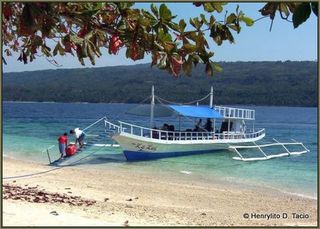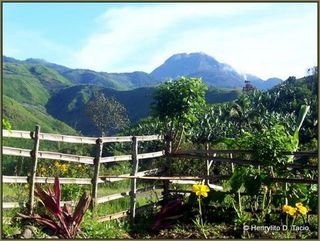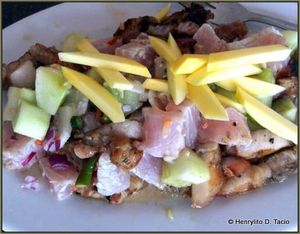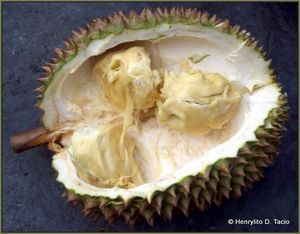The Philippines offers the intrepid tourist variety, physical beauty and challenges, a photographer’s heaven and food like nowhere else on earth - or under the sea. Henrylito D. Tacio reports.

Other might disagree, but Filipinos are adamant their beaches are the best in the world
Manilla, 2 March 2011. There is no doubt the Philippines lends itself to natty one-liner descriptions. “The Christian country of Asia.” “The Pearl of the Orient Seas.” “The Melodious Country” – all are fair comments. But even more importantly, it is an easy to get to country that boasts some unique and truly superb destinations.
Take for example its beaches. The phrase “Life is a Beach” could have been created for Filipinos. With a coastline of 26,289 kilometers (almost twice that of the United States), the Philippines has the third longest combined coastlines in the planet (after Canada and Indonesia).
From the stormy yet challenging yachting seas of Batanes to the emerald isles of Palawan, and the most stunning beaches ever at Boracay in Panay Island, the desert island atmosphere reigns supreme. And Siargao’s Cloud Nine in Mindanao, discovered by American surf photographer John Callahan in 1993, is said to offer some of the best surfing in the world.
If you fancy some slightly deeper water, the Mindanao Trench, just off the island of the same name, is the world’s second deepest spot underwater at about 34,440 feet (10,497 meters) below sea level. Intrepid divers might want to look out for some strange deep water animals there that exist nowhere else on the planet.

Interested in volcanoes? The Philippines has lots of them - look, here's one now!
The Tubbataha Reefs in Sulu Sea marine park, declared the world’s richest “bio-geographic area” in 1988, covers 33,200 hectares and contains what is believed to be the world’s largest grouping of marine life per unit area. If you like water, the Philippines is the place to go.
Landed Gentry
If you are not so keen to get your feet wet, then there are plenty of other attractions in the area from mountains to wonderful landscapes. Touted as the “Eight Wonder of the World,” the rice terraces of Banaue– otherwise known as the “stairways to the sky” – are about 13,500 miles long, or about half the globe’s circumference. The record doesn’t say how much rice they produce, but it would fill a bowl or two, for sure.
Further south, the eruption of Mount Pinatubo created a queer landscape that is only now coming back to normal. Roofs of houses and churches peek through the massive ash layer, with whole villages completely buried. Other examples of nature’s peaks include Mayon Volcano in Albay, which has a nearly perfect cone, and Taal volcano, said to be the world’s smallest volcano, is described as “an island within an island, a volcano within a volcano.”
Underground, the Philippines boasts the 8.2 km St. Paul Subterranean River. This is just part of the 4000-acre cave in Palawan, and not far from the towering limestone cliffs of El Nido, famous for its bird’s nest climbers that harvest their crop with extraordinary balance and strength.

Fancy a snack? How about some tasty kinilaw with pork.
And the capital, Manilla, offers a rich experience from its ancient, majestic churches to its rather less majestic slums and the old Spanish fortified ruins. The architecture is everything from wooden huts to stone and concrete colossi in the city. In may places, the original ancestral home, and still the home of Filipinos in rural areas, is the bahay kubo, (or nipa hut). This pre-Hispanic architecture is perfectly adapted to the climate and can be easily repaired or rebuilt after the frequent typhoons, floods or earthquakes using simple tools and native materials.
Food
Filipinos love to eat. And they have plenty of opportunity. The Guinness Book of World Records lists the Philippine mango as “the sweetest fruit in the world.” Then there is the durian, the fruit that “smells like hell” but has “a taste like heaven.” Other tropical fruits you can find in the country include banana, mangosteen, marang, papaya, melon, guava, pomelo, caimito, chico, and santol. All luscious tropical mouth-waterers.

It doesn't smell that good, but it tastes so creamy you wouldn't believe it's the same fruit
Filipinos are also noted for their weird if not outrageous foods like balut (once featured in the TV reality show, Fear Factor), kinilaw, patis, and bagoong. Many visitors love to eat the delicious chicken adobo and the crispy lechon, fried pork and bacon specialities. Not the kind of thing that is recommended by dieticians, but tasty as they come. The mix of indigenous, Spanish and American influences makes local food a treat for the taste buds.
Flowers abound, too. Sampaguita, which is of jasmine variety, was adopted as our national flower in 1934. But the most captivating is an orchid called waling-waling. Named in “allusion to a moth in flight,” it was discovered on Mindanao in 1882. It used to grow on tree trunks in the rainforests of Davao, Sultan Kudarat and other parts of the island and is touted as the queen of Philippine flowers. In fact it is worshipped as a diwata (fairy) by the native Bagobos.
Text and Photos by Henrylito D. Tacio